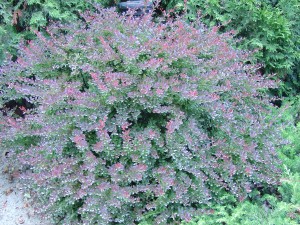Japanese barberry (Berberis thunbergii) is a very popular landscape shrub. Japanese barberry is indigenous to Eastern Europe and Asia and is commonly planted in USDA hardiness zones 4-8.
There is justified concern over the invasive nature of Japanese barberry. A number of states have declared most barberry species (Berberis spp.) to be invasive and have banned its future use. Invasive plants may displace and overtake native species, thereby reducing biological diversity. Native fauna populations, which depend on native species for food and shelter, also suffer.
Cultivar selections are very numerous. Shrub sizes may vary from 5 to 8 feet in height and 6 to 9 feet in spread. Foliage colors range from green, yellow, gold, purple, red and variegated types. Dark yellow flowers bloom in early spring, and many set few to large crops of small bright red berries which may persist into the winter.
Japanese barberry thrives in full sun and in any soil that is well-drained. It tolerates urban air pollution, moderate shade, and drought. Japanese barberry is effective as a living fence or hedge in yards and parking areas. It also makes a thorny deterrent against deer.
Current research on Japanese barberry centers on evaluating the seed viability of current cultivars and to breed new sterile (seedless) cultivars. ‘Aurea Nana’, ‘Aurea’, ‘Bagatelle’, ‘Golden Devine’, and Mentor barberry (B. x mentorensis) have a low seed count. ‘Aurea Nana’, ‘Aurea’, and ‘Golden Devine’ sport vibrant yellow leaves, while Bagatelle has red leaves and Mentor has green leaves.


 Posted in
Posted in 
